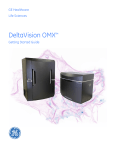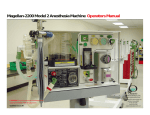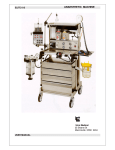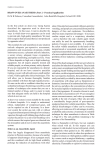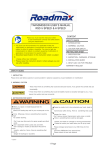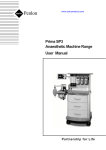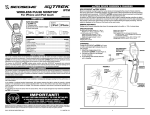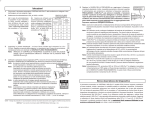Download Print The Above Information
Transcript
Magellan-2200 Model 2 Anesthesia Machine Service Manual 8005 Shannon Industrial Park Lane Atchison, Kansas 66002 Tel: 913 874 2000 Fax: 913 874 2005 Email: [email protected] Version: 082206 2 TABLE OF CONTENTS PAGE SUBJECT • Factory Address and Communications 3 • Purpose 3 • General Poicy 3 • Factory Testing 3 •Equipment and Tools Needed for Service 3 • Routine Testing 4 • Annual Maintenance, Parts Needed and Testing 4 • Exploded View of Ventilator Control Knobs 11 • Testing After Storage 12 • Re-Supply Component Kits and Installation Intervals 12 • Maintenance Components, Kits and Installation Intervals 12 APPENDIX 13 • Specifications of Magellan-2200, Model 2 13 • Problem Solving 15 • Complete List of Part Numbers and Nomenclature 15 • Exploded View Diagrams 19 • Gas Flow Diagrams 21 3 FACTORY ADDRESS AND COMMUNICATION INFORMATION EQUIPMENT NEEDED FOR BENCH TESTING Address: 8005 Shannon Industrial Park Lane Atchison, KS 66005 1. Operators Manual Phone: 913 874 2000 Fax: 913 874 2005 E-mail: [email protected] Website: www.oceanicmedical.com Office Hours: Monday through Friday, 08:00 to 16:00 CDT 2. Pre-Use Check List: Contained in this manual, the Operators Manual and Separate Laminated Card 3. Regulated, Pressurized Gas Sources: Wall outlets for oxygen and air, gas cylinders for oxygen and air, each with appropriate pressure-reducing regulators, portable medical grade air compressor and oxygen concentrator. 4. Mechanical or Electrical-Mechanical Test Lung: The factory utilizes the Bio-Med VT-2A Test Lung, however, other brands of such devices may be used for bench testing PURPOSE OF THIS DOCUMENT This Service Manual provides the reader with important information concerning the general service, maintenance and general repair of the Magellan-2200, Model 2 Anesthesia Machine. This manual will allow for the service of the Magellan-2200, Model 2 Anesthesia Machine and its accessories. This machine may be fully serviced outside of the factory and the reader may contact the factory at any time for assistance. GENERAL POLICY STATEMENT The scope of this manual covers general maintenance, calibration of controls, disinfecting procedures and replacement of certain components at the intervals indicated within this document. FACTORY TESTING Each Magellan-2200, Model 2 Anesthesia Machine is tested utilizing certain testing equipment which may or may not be available in the field or in a general biomedical maintenance facility. This manual will explain how the Operator and Biomedical Technician may completely and safely maintain this equipment. USE AND OPERATION The use and operation of the Magellan-2200, Model 2 anesthesia machine should be performed by a physician, anesthesiologist or certified registered nurse anesthetist (CRNA) trained properly with this device. 5. Hand-Operated Spirometer: May be used for gas volume calibration if other mechanical test lungs are not available. 4 6. Rubber Test Lung or Any One Liter Rubber Test Lung or One Liter Gas Reservoir Bag: Used to simulate patient delivered gas volumes if mechanical Test Lung is not available. 7. Carbon Dioxide Absorber: King Systems KAB-9 unit, either full of absorbent or empty. 8. Patient Tubing Circuit: Any approved Patient Tubing Circuit for Anesthesia may be utilized. 9. Monitoring Device for Anesthetic Agent: Either a specific vaporized agent testing device such as a Bickford Anesthesia Agent Tester, Model-3, or an anesthesia monitor capable of measuring vaporized agent may be used. 10. Tools: The Magellan-2200, Model 2 Anesthesia Machine was designed to be serviced with the following common tools: ANNUAL MAINTENANCE, PARTS NEEDED AND TESTING Recommended Inspection/Replacement of Certain Components A. Annually: The following procedures should be used to ensure proper operation of the machine, at least once per year or at any other interval that the Biomedical Technician deems necessary. B. Parts Needed: The following parts will be needed for Annual Service • Inlet Filters (2 each) P/N 11.3 • Bellows, Latex-free, P/N 13.1 1. Changing the Gas Manifold Inlet Filters: A. 1/16" Allen's Wrench-used with O2 flowmeter control knob and the three ventilator control knobs. B. Screwdriver, regular slotted head. C. Small, adjustable crescent wrench, or: 1. 1/2" open head wrench 2. 7/16" open head wrench 3. regular pliers D. 1" sealing tape roll E. Tube of Krytox (or other oxygen compliant) lubricant F. Water-based leak testing solution Air (DISS) Inlet Connector: A. Using a crescent wrench, unscrew the DISS Air inlet connector and remove. B. Remove the filter spacer (aluminum ring) then remove the cone-shaped filter. C. Inspect the filter for debris. If debris is found, remove it. D. Install the filter back into the Gas Manifold (with original or new filter) with the small end first. E. Install the filter spacer (aluminum ring). F. Pull open the one-way valve (located on the end of the threaded portion of the DISS adapter), and apply some Krytox (or, equivalent) lubricant. 5 G. Re-tape the DISS Air connector, threaded portion, with sealant tape. 2. Replacement of Rubber Bellows and Inspection of Exhalation Diaphragm Valve H. Re-install the DISS Air connector, screwing it closed, snugly, with the crescent wrench. A.Removal of Ventilator and Bellows Systems from Main Frame: 1. Turn anesthesia machine on the Vaporizer side of the machine. Oxygen (DISS) Inlet Connectors: (the first one is located next to the Air Connector, the second one is located on the left-hand side of the Gas Manifold and the procedure is identical for both Oxygen DISS Inlet connectors.) A. Using a crescent wrench, unscrew the DISS Oxygen. B. Remove the filter spacer (aluminum ring) then remove the cone-shaped filter. C. Inspect the filter for debris. If debris is found, remove it. D. Install the filter back into the Gas Manifold (with original or new filter). E. Install the filter spacer (aluminum ring). F. Pull open the one way valve (located on the end of the threaded portion of the DISS adapter) and apply some Krytox (or, equivalent) lubricant. G. Re-tape the DISS Oxygen connector, threaded portion, with sealant tape. H. Re-install the DISS Oxygen Connector(s), screwing it closed, snugly, with the crescent wrench. 2. Using a flat head screwdriver, remove the ventilator retaining screw. 3. Lay the machine down in its normal operating position. 4. Remove the two retaining knob/screws on the backside of the ventilator. 6 5. Disconnect the ventilator gas power tubing from the Ventilator GasPower Toggle Selector Switch by pushing in on the tubing and simultaneously pushing inwards on the retainer ring located on the tubing inlet receptacle. 6. Remove the ventilator/bellows system by pulling the assembly forward from the main frame. B. Removal of Rubber Bellows from Bellows Base, Inspection of Exhalation Valve Diaphragm Valve and Installing New Bellows 1. Turn the clear plastic bellows canister cover counter-clockwise until the four plastic retainer parts are clear of the black plastic retainers, (located on the top of the base of the bellows assembly) and gently remove the clear plastic bellows canister cover, using an upwards motion. 2. Remove the rubber bellows from the Bellows Base. 7 3. Each time the bellows assemblies are opened for inspection and cleaning, all visible components must be carefully inspected and damaged parts must be replaced. Bellows: The bellows is an elastomer material and deteriorates over time. Inspect the bellows every six months if the system is in use. Inspect on the appropriate schedule (annual, to a period of 3 years) if the system is in long term storage. Replace the bellows if there is any sign of deterioration. 5. Using Krytox (or equivalent lubricant) place a small amount of the lubricant on the hard plastic top ring of the bellows. 6. Using Krytox (or equivalent lubricant) place a small amount of the lubricant on the bottom ring of the clear plastic bellows canister cover. Exhalation Valve Diaphragm: The exhalation valve diaphragm valve is under the bellow and can be removed by loosening the three thumbscrews. The valve seat is now visible. WARNING: During inspection and cleaning (to remove contamination) of the valve seat and diaphragm, use a soft cloth or brush. Abrasive materials may damage the seat and should not be used. To preclude damage caused by the patient breathing into the valve, you should use a bacterial filter in the expiratory breathing circuit. Clean the seat (A) and the metal disk (B) attached to the base of the diaphragm valve thoroughly and remove any contamination from the surfaces of both components. NOTE: Any anesthesia breathing circuit filter may be used. After cleaning, check the small O-Ring (C) located in the bellows base under the diaphragm valve is in place. The system will not function if the O-Ring is not in place. Refit the diaphragm valve assembly to the bellows base and reassemble the bellows assembly. 4. Install new bellows to bellows base by placing the bottom bellows crease over the lip of the bellows retainer. (See photos to the right.) NOTE: Once the bellows is installed, turn the vent/bellows system upside down and observe that the bellows fully expand and the folds are evenly opened. Re-adjust the bellows fold where it is attached to the base and re-observe the expansion. 7. Re-install the clear plastic bellows canister cover by pushing the clear canister down firmly over the bellows base, then turning the canister cover clockwise until the retainers are completely covered by the retainer clips. 8 8. Re-install the ventilator/bellows system: A. Place the ventilator/bellows system partially in place. B. Re-install the ventilator power tubing into the Gas Selector Switch receptacle by pushing the tubing firmly into the receptacle, then pulling the tubing backwards, firmly. C. Push the ventilator/bellows system back into its normal position. D. Re-install the two ventilator base knob-screws from the backside of the machine frame. E. Turn the entire machine onto the vaporizer side of the system. F. Re-install the ventilator retaining screw into the bottom of the ventilator through the bottom of the machine frame. 9 3. Mandatory Replacement of Gas Manifold - High Pressure Color-Coded Tubing Yellow Tubing Positions From Gas Manifold to: Every five years or, at any necessary time, each of the 10 color-coded tubes that attaches to/from the Gas Manifold should be replaced using the following procedure: A. Air Pressure Gauge B. Air Position on the Ventilator Gas Selector Toggle Switch C. Air Flowmeter A. Green (oxygen) and Yellow (Air) Tubing: The connectors from the Gas Manifold to each of the following components are of the "push-to-insert-and-lock" type. II. ROUTINE FUNCTIONAL TEST : The functional test may be done at annual intervals or at any time that internal componenets have been replaced. B. To dismount, push in on the outer ring and pull the tubing out. NOTE: The Routine and Annual Functional Test may be carried out at any interval. This test will indicate any malfunction of the machine or its components and the Operator or Biomedical Technician will be able to rectify any component that is not functioning properly. NOTE: The end of the color-coded tubing must be squarely cut; angled ends may not seat properly. C. To re-insert, push the end of the green tubing into the receptacle and then use a "pulling" action to lock the tube in place. Test Procedure: 1. Assemble and install all components needed for routine clinical use of the machine as outlined in the Operators Manual, or the Laminated Set-Up Card. 2. Perform the Pre-Use Checklist and Laminated Set-Up Card (with photos) in sequence. This Checklist is contained in the Operators Manual; the separate Pre-Use Checklist laminated card and Set-Up Card are provided with each machine. Green Tubing Positions From Gas Manifold to: A. Auxiliary O2 Flow Selector B. O2 Pressure Gauge C. O2 Flush Valve D. O2 Flowmeter E. O2 Position on Ventilator Gas Selector Toggle Switch Calibration Guide in the next section. F. O2 Concentrator/High Pressure O2 Selector Toggle Switch G. O2 Low Pressure Alarm CAUTION: If the machine does not pass the Pre-Use Checklist, correct the problem(s) encountered, then proceed with the Calibration Guide. The Problem Solving Guide on page 13 of this Manual will assist the Operator in resolving possible common problem situations. H. O2 Very Low Pressure / O2 Concentrator Pressure Alarm NOTE: If the machine passes the Pre-Use Checklist with zero problems, proceed to the 10 Calibration Guide: CAUTION: The factory utilizes pressurized Air and Oxygen set at 50 PSI for all testing. It is recommended that this pressure be used when possible. If higher or lower inlet pressures are routinely utilized the ventilator may be re-calibrated at pressure inputs from 40 to 70 PSI. Calibration Materials Required: • Source gas of air or oxygen • Appropriate hose set to connect to gas source • Pre-Use Checklist • Operating Ventilator • Test Lung • Patient Tubing Circuit Procedure: • Attach the patient circuit to the equipment and to the test lung. • Set Minute Volume control knob to 10 LPM. • Set Frequency conrol knob to 13 BPM. • Ensure the bellows is fully inflated. • Pressurize the ventilator and allow the system to cycle several times. • Verify the following values on the test lung: Minute Volume = 10 LPM BPM = 13 per minute Tidal Volume = 770 MI NOTE: Values should be +/- 10% of settting. 11 2. Ventilator Gas Power Toggle Switch - Select either Air or Oxygen as the power source. NOTE: Ensure that the Oxygen system toggle switch is in the high-pressure position. 3. Re-Calibration of Individual Control Knobs Tools needed: Test Lung. A. Remove Control Knob by grasping the knob firmaly and pulling it straight off the shaft. B. With the ventilator still cycling, turn the valve shaft until the proper value is shown on the test lung. C. Replace the Control Knob by facing the pointer to the desired value and pushing it straight on to its full extent. D. Verify the values are now correct. NOTE: The results of calibration can vary depending on the test lung utilized. Reservoir bag and rubber test lungs may not inflate fully or over-inflate, causing erroneous results. III. TESTING AFTER STORAGE The following procedures should be used after the Magellan-2200, Model 1 Anesthesia Machine has been stored for 6 MONTHS OR LONGER. 1. Set the machine up and prepare for Bench Testing by placing all components needed on the machine as though preparing for actual use. 2. Use the Pre-Use Checklist and verify that all components are ready for use. 3. Inspect the machine for gas leaks, such as the high-pressure gas hoses, gas connectors and pressure-reducing regulators. 4. Allow the machine to function for 30 minutes and re-inspect the device for any discrepancies. 5. If any problems are observed, perform the Annual Maintenance and test procedure to re-qualify the machine and return to storage or service. 12 IV. SERVICE KIT FOR MAGELLAN-2200 ANESTHESIA MACHINES Part Number OEM PN with CAGEC NSN Description A-108 Annual Services Component Kit consists of: Page No. or Drawing No. NOTE: The A-108 Kit is comprised of the following components. Individual components may be utilized at any interval without installing the complete Kit. A-108.1 Bellows, Latex free A-108.2 Tubing Kit with valves A-108.3 Vaporizer End Caps A-108.4 Manifold Filters and Spacers A-108.5 Tweezers for removing Filters and Spacers A-108.6 1/16” Allen Wrench A-108.7 Squeeze Bulb with Common Gas Outlet Adapter A-108.8 Tubing, Color Coded A-108.9 Scavenger Tubing with wye and Bellows Adaptor A-108.10 Service Manual CD A-108.11 Krytox Lubricant Tube, 1/2 oz. A-108.12 Yoke-type Regulator Washers 13 OTHER COMPONENT SERVICE 1. Vaporizer Refer to provided Penlon, Ltd. Vaporizer Manual 2. Air Compressors Refer to provided Vortran, Inc. Air Compressor Manual APPENDIX: (INDIVIDUAL PAGES) SPECIFICATIONS Subject Page Number SPECIFICATIONS FOR MAGELLAN-2200, MODEL -2 13 PROBLEM SOLVING 15 COMPLETE PARTS LISTING OF ENTIRE ANESTHESIA MACHINE 16 GAS FLOW DIAGRAM 21 MACHINE DIMENSIONS: Height 53.4 cm 23 inches Depth 53.4 cm 23 inches Width 43.2 cm 17 inches Weight 20.4 kg 45 lbs Machine Materials Aluminum, brass and plastic CASE DIMENSIONS: Height 66.0 cm 23 inches Depth 60.96 cm 24 inches Width 53.34 cm 17 inches Weight 121.2 kg 200.5 kg 55 lbs (empty) 100 lbs (machine with accessories) Case Materials Polyethylene, dyed green Operating Temperature Range 1.6˚ C to 43.3˚ C (35˚ F to +160˚ F) Relative Humidity (in use) 30 to 90%, non condensing Relative Humidity (storage) 40 to 90%, non condensing Required Gas Supply Sources • O2 Main and Cylinders • Air and/or Air Compressor • Oxygen Concentrator Flowmeter Fresh Gas Flow 38 to 70 psi (50 psi is optimal) 38 to 70 psi (50 psi is optimal) 3 to 10 psi 1 to above 20 lpm (each flowmeter) 14 Oxygen Flush Valve Recessed, self-closing, push-button, color coded and labeled, provides 45-55 lpm constant flow, while push-button is depressed; may be used sparingly with O2 concentrator as O2 power source Oxygen Analyzer/Monitor OM-25-ME (or equivalent) Galvanic cell sensor, life expectancy 2 years under normal conditions Oxygen Analyzer Power Source 2 each AA batteries, life expectancy approx. 3000 use hours Auxiliary O2 Flow Selector Scaled 0-10 LPM in set increments, used for pre/post anesthesia Vaporizer Penlon SigmaDelta Series, bolt (cage) mounted, temperature compensated, very low maintenance Airway Pressure Gauge Dual scaled in cmH2O and mmHg, located on front panel of ventilator CO2 Absorber System King Systems KAB-9 (re-fillable) or KAB-1 (pre-filled/disposable) CO2 Absorber Canister Capacity 400 grams soda lime Directional Valves Built in the CO2 Absorber CO2 Absorber Holding Bracket Plastic, secured with knob to main frame of machine Bag-Ventilator Switch/PRV and Scavenger Outlet Port Hand-operated selector switch and rotating knob for PRV and scavenging outlet Pressure Gauge Tubing May be attached to bag/vent switch arm or to a point within the patient breathing circuit (operators choice). Bellows Latex free, upward inflating, range from 0 to 1.6 L Mechanical Ventilator Bellows Pressure Relief Pre-set at 60 cmH2O Pneumatically powered, time cycled, volume constant, volume variable Common Gas Outlet Quick-connect, size indexed Tubing Circuit King Systems F-360-61 or any standard anesthesia circle circuit Gas Pressure Hoses DISS and thread indexed, female connectors at both ends Gas Inlet Manifold DISS and thread indexed, male connectors with one-way valves Gas Inlet Manifold Filters Located behind Manifold Air and O2 inlet male connectors Gas Inlet Pressure Regulators • Main supply cylinder • Safety back up cylinder DISS/thread indexed for O2 Pin-indexed, yoke mounted for "D" and "E" cylinders for O2 Oxygen and Air Supply Gauges 0-3000 psi range, color coded and clearly labeled Oxygen Supply Alarms • Main and safety back-up • O2 Concentrator • Alarm power source • Alarm on/off Air and O2 Flowmeters Pneumatically actuated when O2 supply falls below 30psi Pneumatically actuated when O2 supply falls below 1 psi 9-volt battery located in body of alarm box Labeled toggle switch located on body of alarm box Calibrated and scaled 0-10 lpm, color coded, O2 flowmeter has a fluted control knob for easy identification by touch, alone Oxygen Concentrator To power O2 flowmeter only Air Compressor May be used to power ventilator and air flowmeter • Ventilator Pressure Relief Pre-set to maximum of 60 cmH2O located in main vent box • Pressure Relief Valve Preset to 60 cmH2O Ventilator Gas Power Requirements 40 to 70 psi, 50 psi optimal Use toggle switch to select gas source Waste Gas Scavenger Positive and negative relief valves, 1 L reservoir bag, vacuum control knob Total Machine Gas Leakage @ 30 cmH2O @ 80 cmH2O -0- ml/Min 100 ml/min Internal System Compliance @ 20 cmH2O @ 40 cmH2O 1.1 ml/cmH2O 1.3 ml/cmH2O Internal System Resistance @ 1.0 L/sec gas flow @ 0.5 L/sec gas flow 4.11 cmH2O 1.80 cmH2O APL Valve Pressure Drop @ 3.0 L/min gas flow @ 30 L/min gas flow 0.12 cmH2O 1.03 cmH2O 15 PROBLEM SOLVING GUIDE PRE USE CHECKLIST PROBLEM SOLUTION Low O2 Pressure Alarm Activates • Check main pipeline O2 gas supply and the emergency O2 backup cylinder by observing the gas pressure gauges. Resolve by ensuring adequate pipeline and cylinder O2 supplies are adequate and are attached to anesthesia machine. Soda Lime in absorber canister changes color from white to blue • Replace soda lime in canister Reservoir Bag does not inflate • Check Bag/Vent Switch for "vent" position • Check PRV Control Knob for "closed" position • Check entire tubing circuit for leaks Oxygen Sensor does not calibrate • Check O2 supply and O2 Pressure Gauge to ensure O2 is available • Check O2 sensor to ensure proper seating in "tee" adapter • Check that opposing (Air or O2) flowmeter is OFF Ventilator does not cycle • Check Air or O2 gas power supply for 40-70 PSI on pressure gauges • Check Vent Power Selector Switch in Air or O2 position • Check expiratory time control to ensure settings • If O2 is selected for power, check O2 Power Selector Toggle Switch and ensure it is in the High Pressure Position Bellows do not evenly expand or deflate • Check top white plastic ring for proper lubrication Bellows holds pressure during expiratory phase • Inspect relief valve at base of bellows for debris Water particles appear in air flowmeter flowtube • Insure that water trap is instaled on air inlet located on the back of the gas manifold Unwanted postive pressure is indicated on pressure gauge during end-exhalation • Remove PEEP valve from system and check for kinks at ET tube/patient tubing circuit See Operators Manual 16 PART LIST FOR MAGELLAN-2200, MODEL-1 PART NO. NSN DESCRIPTION PAGE NO. Listed by Assembly Section, in Bold Type. NOTE: Some numbers are repeated as these are used in additional assembly. PART NO. NSN DESCRIPTION PAGE NO. 4.3 1/8" Hose Connector, Locking, 90 degree DESCRIPTION PAGE NO. 8.0 Oxygen Pressure Gauge, Green Dial 1.0 "L" Frame, Aluminum with 8-32" Brass Mounting Screws (4 each) 19 7.1 Female/Female Coupling, 1/8" NPT 2.0 Flowmeter Pair, Air and Oxygen with Holding Nuts 19 4.3 1/8" Hose Connector, Locking, 90 degree 2.1 1/8" Hose Barb 20 9.0 Auxiliary Oxygen Flow Selector 2.2 Hose Connector, Locking, Straight 7.1 Female/Female Coupling, 1/8" NPT 2.3 Knob, Green, Fluted for Oxygen Flowmeter 4.3 1/8" Hose Connector, Locking, 90 degree 10.0 Main Body Frame, Aluminum 19 10.1 Support Rods, Brass (2 each) 19 10.2 1/-20 Rod Screws, Brass (4 each) 19 10.3 Dowel Pin for B/V Switch Mounting, Brass with -20 B rass Screw 19 2.1 1/8" Hose Barb, O2 Concentrator Inlet 7.1 Female/Female Coupling, 1/8" NPT 7.2 1/8" Hose Connector, Locking "Y" Outlet 11.0 Gas Manifold Body 20 11.1 DISS Adapter, Air, with one way valve 4 11.2 Spacer, length specific, retains bronze filter 4 11.3 Bronze Filter, cone shaped 4 PART NO. NSN Knob, Black, for Air Flowmeter 20 3.0 Common Gas Outlet Body and Holding Nut 19 3.1 Common Gas Outlet Coupling Insert 12 (Ops) Oxygen Flush Button Assembly 4.1 Gas Actuator Assembly 2.1 1/8" Hose Barb 4.3 1/8" Hose Connector, Locking, 90 degree 5.0 Ventilator On/Off Toggle Switch with Holding Nut 4.3 1/8" Hose Connector, Locking, 90 degree (3 each) 6.0 High Pressure O2/O2 Concentrator Toggle Switch with Holding Nut 19 20 2.4 4.0 19 19 20 19 19 4.3 1/8" Hose Connector, Locking, 90 degree 11.4 DISS Adapter, Oxygen, with one way valve (2 each) 4 2.2 1/8" Hose Connector, Locking, straight (2 each) 11.5 Spacer, length specific, retains bronze filter (2 each) 4 11.3 Bronze Filter, cone shaped (2 each) 4 2.2 Hose Connector, Locking, Straight (2 each) 4 7.0 Air Pressure Gauge, Yellow Dial 7.1 Female/Female Coupling, 1/8"NPT 19 17 PART NO. NSN DESCRIPTION PAGE NO. PART NO. NSN DESCRIPTION PAGE NO. PART NO. NSN DESCRIPTION PAGE NO. 17.0 Bulb, Squeeze/Hi-Lo Pressure Check w/ CGO Adapter and Tubing 11 (Ops) 18.0 Alarm, Low Pressure Mains O2, Container 20 18.1 30 psi, Electric Switch 7.2 1/8" Hose Connector, Locking, "Y" Outlet (3 each) 2.2 Hose Connector, Locking, Straight (2 each) 4 11.6 Nylon Screw Plug 4 12.0 Ventilator Container Main Body 20 18.2 Switch Cover 12.1 Container Front Plate 20 18.3 Alarm Beeper 12.2 Container Back Plate 20 18.4 Alarm Plunger 12.2-A Container, Top Plate, Bellows Body Attachment Part 20 18.5 9-Volt Battery 12.30 Semi-Locking Control Knobs, (3 ech) Insp Flo/Insp Time/Expir Time 18 19.0 Alarm, O2 Concentrator, Low Pressure, Container 19.1 1 psi, Low Pressure Electric Switch 13.0 Bellows Assembly Complete 19 18.2 Switch Cover 13.1 Clear Plastic Bellows Cover 6 18.5 9-Volt Battery 13.2 Latex-Free Rubber Bellows 6 13.3 Knob-Screws to hold Bellows Assembly to Ventilator Cover Plate (4 each w/nuts) 6 23.0 Vaporizer Retainer, Aluminum 20 23.1 Retainer Holding Knob-Screws (2 ea) 20 14.0 Bag/Vent Switch/Pressure Relief Valve/Scavenger Outlet 19 24.0 Vaporizer, Agent Specific 20 14.1 B/V Switch Support Arm w/ Connectors for Reservoir Bag/CO2 Canister Tube 19 24.1 End Cap, Inlet Port for Tubing from Flowmeters, Size Specific 16 (Ops) 24.2 End Cap, Outlet Port for Tubing from Vaporizer to CGO 16 (Ops) 14.2 Pressure Gauge Tubing Connector, w/one way valve 8 (Ops) 24.3 Cagemount Assembly, Backbar and Holding Knobs 16 (Ops) 15.0 CO2 Absorber Support Arm 8 (Ops) 25.0 Manual, Operator and Service on CD25.1 15.1 1/8 x 1/2" Holding Knob and Screw 8 (Ops) 25.1 Penlon Vaporizer Manual 25.2 Set-Up Card, Pictorial 9 20 16.0 Scavenger, Waste Gas 11 (Ops) 25.3 Pre-Use Checklist Card 9 16.1 Scavenger Tubing (3 ea) and "TEE" Adapter 11 (Ops) 26.0 Oxygen Pressure Reducing Regulator, Yoke Mount 6 (Ops) 16.2 Reservoir Bag, 1 Liter 11 (Ops) PART NO. PART NO. DESCRIPTION DESCRIPTION PAGE NO. PAGE NO. NSN NSN 18 PART NO. NSN DESCRIPTION PAGE NO. 26.3 Oxygen High Pressure Hose, Green, 24" length 26.4 Oxygen High Pressure Hose, Green, 15' length 6 (Ops) 26.5 Air High Pressure Hose, Yellow, 15' length 6 (Ops) A-101 Air Compressor, Vortran HP-70 18 (Ops) A-102 Water Trap for Gas Manifold, Air Inlet Connection 7 (Ops) A-103 Carrying Case, Air Compressor A-104 Carrying Case, Magellan-2200 Anesthesia Machine 5 (Ops) A-105 Oxygen Cylinder Mount for Carrying Case 5 (Ops) A-106 Aluminum Trolley for Magellan-2200 Anesthesia Machine A-107 Oxygen Analyzer/Monitor with Sensor 11 (Ops) A-108 Oxygen Analyzer Sensor Replacement 11 (Ops) A-108 Oxygen Analyzer TEE Adapter 11 (Ops) A-109 PEEP Valve, Magnetic 20 (Ops) A-110 Mapleson/Jackson-Reese CGO Adapter A-111 Service Kit, Annual Maintenance 12 19 MAGELLAN-2200 ANESTHESIA MACHINE – FRONT 20 MAGELLAN-2200 ANESTHESIA MACHINE – BACK 21 GAS FLOW DIAGRAMS 22 23 24 25


























